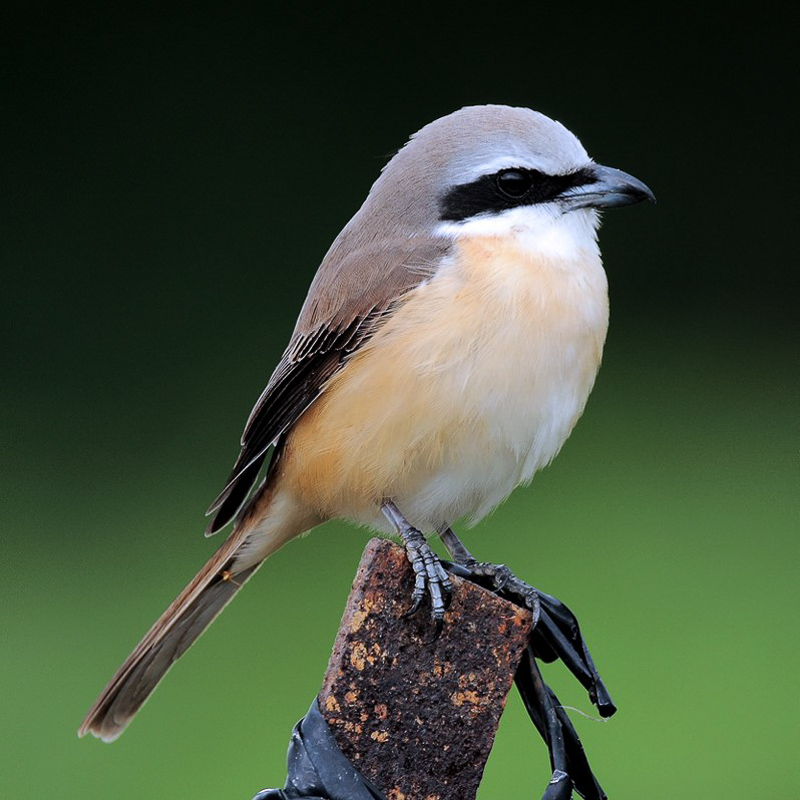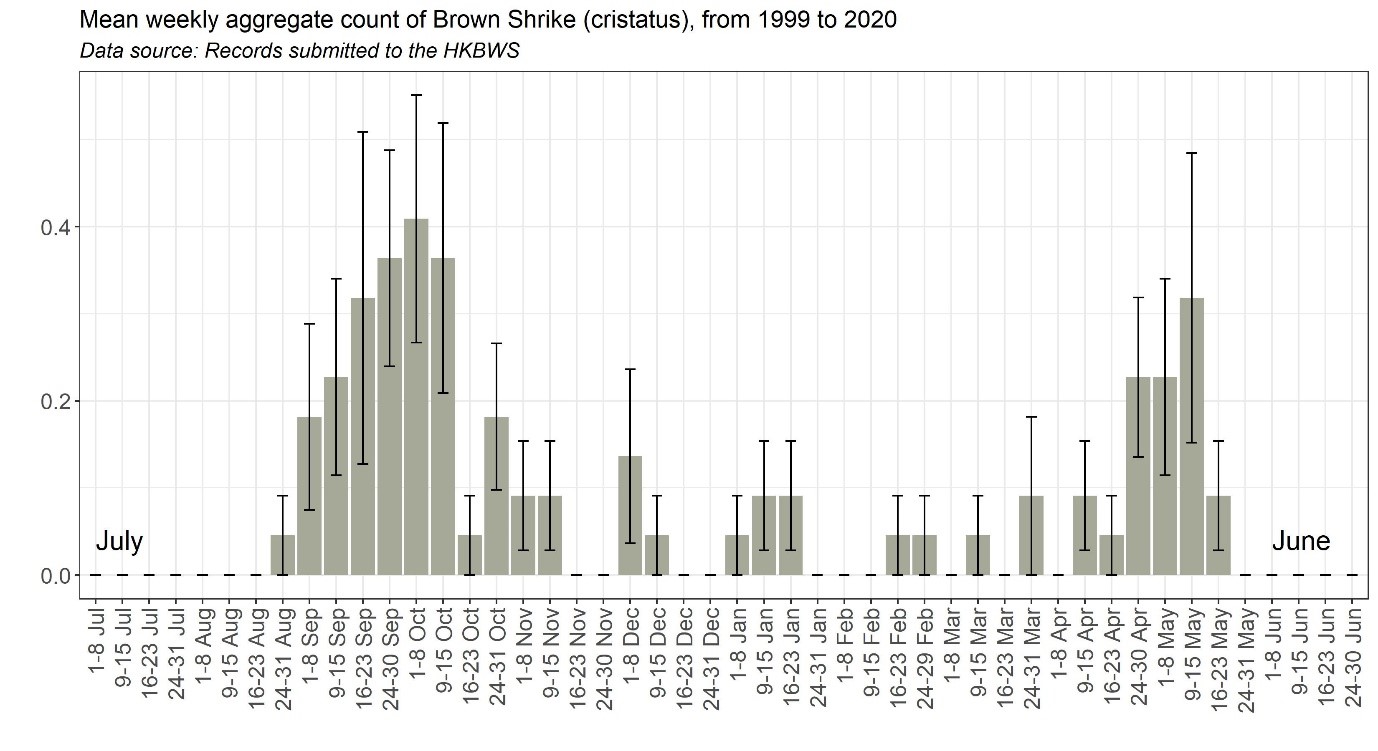Brown Shrike Lanius cristatus 紅尾伯勞
Category I. Common passage migrant in spring, scarce in autumn and rare in winter. Occurs in open-country habitats. Three subspecies probably occur: confusus, cristatus and lucionensis, though the exact proportions of each are uncertain.
IDENTIFICATION

Apr. 2010, Michelle and Peter Wong. Adult.
17-20 cm. A medium-sized shrike with rather large head and, in adult plumage, black facial mask from lores to rear ear-coverts. Underparts variable buff that is probably related to subspecies; females are paler with blackish-brown mask and vermiculated sides of breast and flanks.
Compared to other taxa, adult L. c. lucionensis are paler and greyer on the crown and nape with a narrower supercilium and no distinct frontal band. Male L. c. confusus has richer buff underparts and less extensive pale greyish on the crown and nape.

Jan. 2009, Michelle and Peter Wong. First-winter.
First-winter birds a have browner mask that is absent or poorly-marked on the lores, a more diffuse supercilium, vermiculated flanks and chest and largely pale bill.

Sep. 2010, Michelle and Peter Wong. Either nominate cristatus or confusus.
L. c. cristatus has buffish-white lower forehead becoming dull brown on forecrown, rufous-brown crown to nape, russet-brown upperparts and slightly brighter rump and uppertail-coverts. Female is very similar to male, but with finely vermiculated breast sides and flanks.
VOCALISATIONS
Calls are harsh and scolding, repeated trilling ‘jih-jih-jih’.
DISTRIBUTION & HABITAT PREFERENCE
Favours open country habitats including agricultural land, temporarily cleared areas, open-canopy shrubland and grassland, but also occurs in low-density urban areas. Brown Shrike is most frequently recorded at Po Toi, Mai Po, Ho Man Tin, Long Valley, Kam Tin and other open country sites. Wintering birds are more likely to be seen in such habitats as city parks and large gardens.
OCCURRENCE
Brown Shrike has been known in HK since 1860 (Swinhoe 1861) and is largely a passage migrant, common in spring but less common in autumn, and a scarce winter visitor. It is one of the most conspicuous late spring migrants in HK, with main passage occurring from the last week of April to the third week of May, and peak passage in the first week of May (Figure 1). The latest record occurred on 7 June 1977.
Autumn passage is much less marked and usually begins in the last week of August, with the earliest on record occurring on 25 July 1987 and 31 July 1993. Passage continues as a trickle to the last week of November, after when numbers are broadly similar until spring migration. It is scarce in winter.
Most records concern singles or a few birds, though the highest counts both occurred on Po Toi: 95 on 10 May 2014 and 89 on 21 May 2008. Large groups are mostly seen on offshore islands during migration. Of the 28 occasions where more than 30 individuals were recorded, 24 were on Po Toi and two on Tung Ping Chau.
BEHAVIOUR, FORAGING & DIET
Usually occurs singly but occasionally in large though scattered groups. Somewhat shy and retiring and usually does not perch as prominently as other shrikes. Diet comprises mainly invertebrates.
SYSTEMATICS & RANGE
Of the four subspecies, two breed in China: L. c. confusus in Inner Mongolia and Heilongjiang, L. c. lucionensis from Jilin southwest to Gansu and Sichuan and south to northern Guangdong. Both are migratory: lucionensis winters largely in the Philippines but with small numbers in southern China, and confusus winters in peninsular Malaysia and Sumatra (Cheng 1987, Liu and Chen 2020, Yosef et al. 2020).
The other two subspecies occur in China as migrants: L. c. superciliosus breeds in Japan but winters in Yunnan and Hainan, extending to Indochina; L. c. cristatus breeds in the western part of the Palearctic and passes through western China to winter in Yunnan (Cheng 1987, Liu and Chen 2020, Yosef and ISWG 2020).
CONSERVATION STATUS
IUCN: Least Concern. Population trend decreasing.
Figure 1.

Figure 2.

Chalmers, M. L. (1986). Annotated Checklist of the Birds of Hong Kong. Hong Kong Bird Watching Society, Hong Kong.
Cheng, T. H. (1987). A Synopsis to the Avifauna of China. Science Press, Beijing.
Lefranc, N. and T. Worfolk (2022). Shrikes of the World. Helm, London.
Liu, Y. and Y. H. Chen (eds) (2020). The CNG Field Guide to the Birds of China (in Chinese). Hunan Science and Technology Publication House, Changsha.
Swinhoe, R. (1861). Notes on the Ornithology of Hongkong, Macao, and Canton, made during the latter end of February, March, April, and the beginning of May, 1860. Ibis, 3(1), 23-57.
Yosef, R. and ISWG (International Shrike Working Group) (2020). Brown Shrike (Lanius cristatus), version 1.0. In Birds of the World (J. del Hoyo, A. Elliott, J. Sargatal, D. A. Christie, and E. de Juana, Editors). Cornell Lab of Ornithology, Ithaca, NY, USA. https://doi.org/10.2173/bow.brnshr.01

